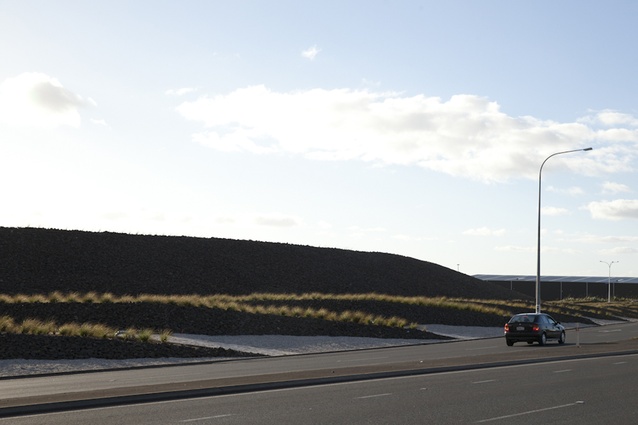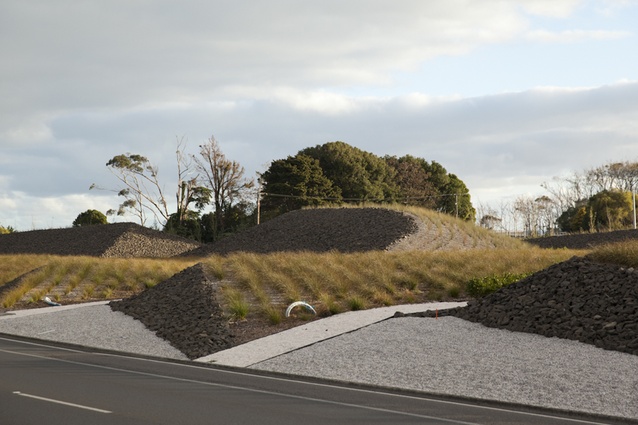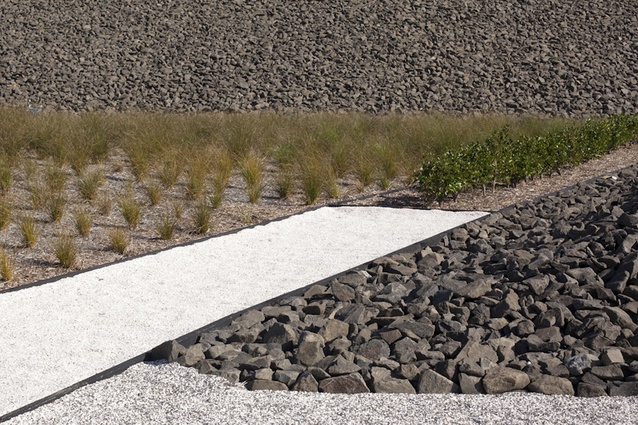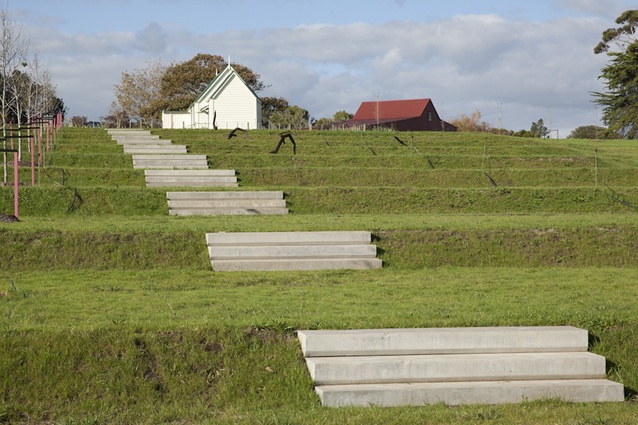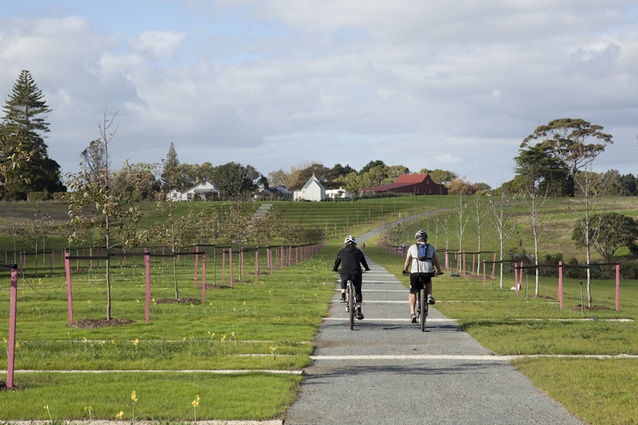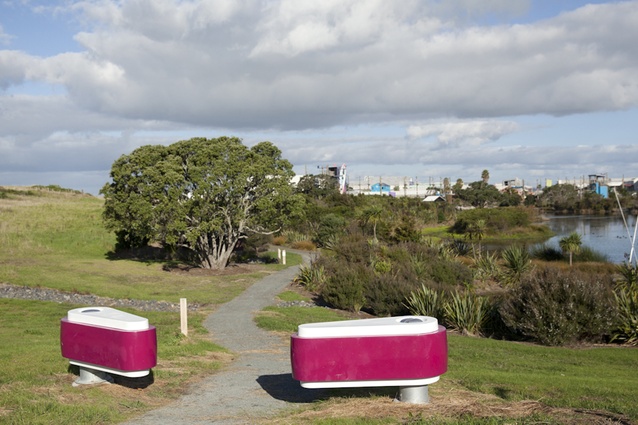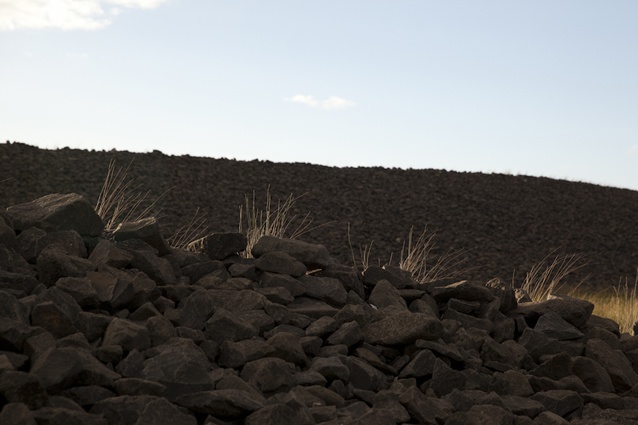Auckland Airport landscapes
In the right conditions, the airborne approach to Auckland Airport is fascinating: a vista of patchwork farmland and green space just holding out against the sprawling city; the scattered volcanic cones; the breadth of the Manukau stretching up to a pinch point of the isthmus somewhere in the vicinity of Otahuhu. Closer still is Puketutu Island, whose scoria cones were sacrificed for fill when, in the 1950s, Auckland Airport’s runway needed an extension. Nearer again there are the stony pastures, mounds and historic drystone walls of the Otuataua Stonefields, almost alien from above in their abstract whorls.
Distance is a great simplifier. Until recently, the land-based approach revealed a different story; one mostly of terminal banality. The airport sits at the end of a highway that offers little honour to the aviator after whom it was named. George Bolt Memorial Drive is an ad hoc place peppered with the necessarily massive tilt-slab constructions the logistics industry requires. Some are garishly coloured and overtly emblazoned, and they weigh heavily on the surroundings. As a place of first and last impressions, you mostly hoped the majority of flights arrived or departed under the cloak of darkness. The airport’s former entrance, if you were alert enough to distinguish it, was so tentative it was almost completely incognito.
James Lord, director of San Franciscan landscape firm Surface Design, the masterplanner of the new airport precinct, used to laugh when he drove off to the city. “The only thing that really let you know you were in New Zealand was when you’d drive by the NZ Vanlines signage.” Lord is a frequent flyer to these shores. He’s an American-Kiwi, or vice versa, with more than a few generations of lineage here.
“With me, there’s this funny inside-outside thing. I’ve been coming to New Zealand all my life. I used to land at the airport when it was paddocks and sheep and people on horses. You knew you were in New Zealand when you landed in New Zealand. However, over time development happens and it seems that no one really takes care. A master plan is partially put in place, but it all falls apart or it’s not enforced.
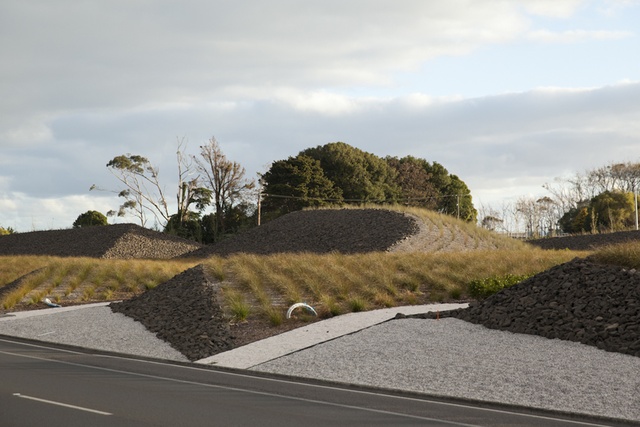
“All that we’re about – our landscape, our culture and our traditions – were pretty much wiped away by engineering standards or infrastructure. We were all being homogenised, and we didn’t know it was happening. You just don’t know until it creeps up on you.”
The trick, he says, is to notice it has happened and do something about it. At Auckland International Airport, someone definitely noticed. Visit the airport today and things are quite different. For starters, when you get there, you really know you’ve arrived. As an entrance piece there are earthworks that cannot be called anything but massive. Viewed from the air, which some have uncharitably suggested might be the best place to view them; this northern gateway is one part land art, one part abstract dunescape. As with anything abstract, you can draw your own conclusions.
It is, however, a carefully orchestrated exercise in precision earthworks – and it’s not tentative or incognito. It’s long and high, with the banks rising to nine-metres in parts. Lord says the wider ambition for the entranceway was for it to extend up George Bolt Memorial Drive and translate as a transect of New Zealand geography and ecology. The completed portion (on airport land) is thematically rooted in the aforementioned dune landscape, planted out with carex and oioi. It is, he says, about a merging of cultures, and a fascination with first responses to this land; how, when people came to New Zealand, they transformed the landscape.
“When Maori arrived with their tropical food sources, they built kumara pits, they carved and lined the earth. When Europeans arrived, they took a different approach but they used the land as well, building giant hedgerows to protect gardens and food crops.
“So there are these two distinct ways that people have engaged with New Zealand through landscape. The piece talks about an engagement with New Zealand. You have these big earth forms that are an abstraction of the kumara pits and on the outside edges run the hedgerows – the two giant hedgerows frame boulevards that you can walk or cycle through, and when the plants get bigger you’ll see this framing of the entrance feature.”
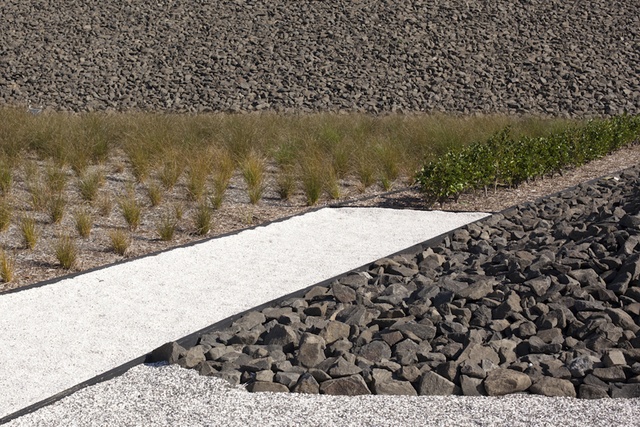
The roads, planted with poplars, recall the farms that were once there; they signal Lord’s intention to intertwine something of the history of the land back into the precinct and to reverse what it had become: “How do you make what most people consider the back door the front door?” he muses. “You’re recalling your own history but you’re doing it in your own way, you’re doing it in a designed way that orients your eye and makes these cultural and physical connections happen.”
Perhaps there’s another underlying theme. At airports there is often a feeling of disassociation with the land (inside airports there’s often a sense of disassociation with time itself). At Auckland Airport, Lord seems keen to address this alienation by connecting people back with the exterior. Today at the airport you’ll find quite an array of leisure-related amenity: an outdoor gallery, a reimagining of an extant stormwater pond as the focus of a new sculpture park filled with New Zealand artworks, an anfractuous mountain bike park, a golf course, a sports field that sits next to the esplanade designed by Bespoke Landscape Architects, an allée-style procession way that leads up to the chapel of Abbeville Estate (also designed by Bespoke), one of a collection of four heritage buildings, two of which were relocated from the proposed expansion to the airport’s runways.
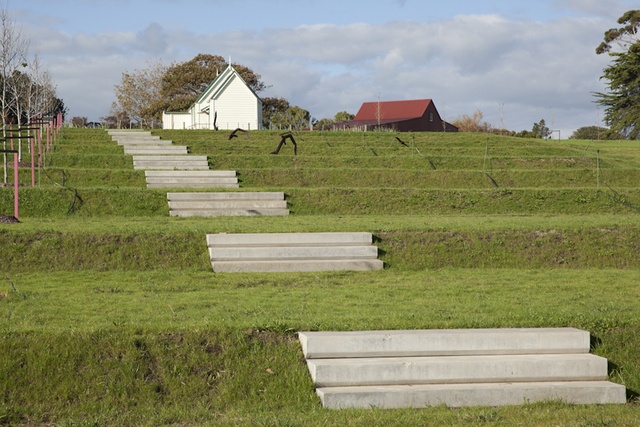
As a counterpoint to the bombast of the airport’s gateway, the aesthetic of the esplanade is calm, colourful and linear. Lee Brazier, director at Bespoke, has set this area up as a “barcoded sequence of shell bands that provide the rhythm and structure”.
“When nothing is up, from a seasonal perspective, when there’s no colour in the trees or life in other elements, there will always be this rhythm and pattern along the ground plane. And that pattern becomes the dividing function for the bulb [daffodils in white and yellow] planting, so you’ve got bulb planting in every second row, and wildflower planting, which comes up in the alternate rows.”
Also in the allée is another counter play of colour in the staking of the trees. The stakes are bold pink on one side, “so when you view it from different angles you either get a staggered effect of plain timber or plain pink”. It’s a nice touch, and reflects a level of thinking right down to the smallest detail.
Last year, at Harvard’s Graduate School of Design, an exhibition, Airport Landscape: Urban Ecologies in the Aerial Age, presented case studies examining the airport as a landscape with complex ecologies, whether as “a form of urbanism to be developed as a city in its own right” or “an ecological or environmental field to be managed”. Auckland International Airport featured in that exhibition, and in its sum of parts you can see the emphasis on making this place an actual place, and not just a final destination.

